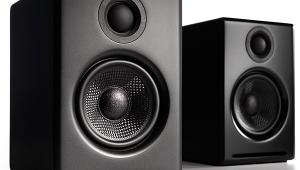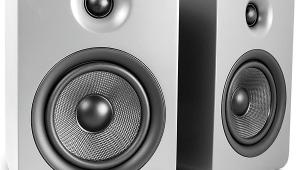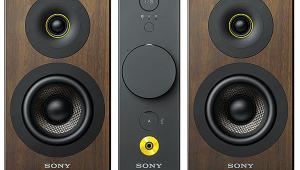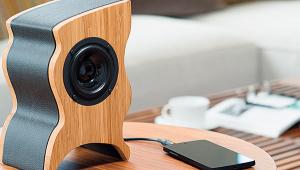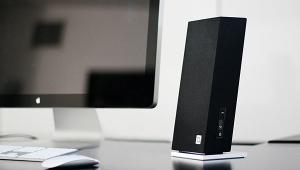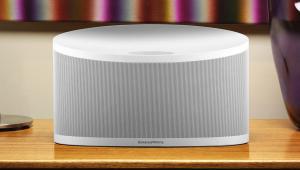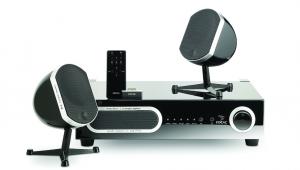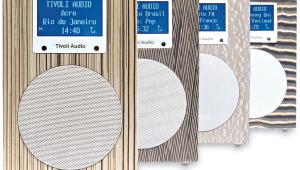Power to the Speakers: Three New Active Desktop Systems Page 2
Paradigm Shift A2 ($560/pair; stands $70/pair, paradigm.com/shift)
Paradigm, the Canadian speaker maker long known for high-performance, high-value passive designs, is in fact no stranger to the active speaker arena. A decade or more ago Paradigm’s Active/20 monitor met a similar fate as Advent’s powered design: knowledgeable pros bowed down in awe, but customers disdained them in droves.
Now Paradigm is having another go, with the initial product in a new, youth-targeted subbrand dubbed (cleverly or annoyingly depending on your POV) Paradigm Shift. The A2 is a multipurpose powered two-way, with each speaker identically self-powered, suggested for use with desktops and laptop computers, portable music players, hi-fi music servers, distributed whole-house systems, electronic instruments, or any other stereo (or mono) source delivering line-level audio.
The A2’s styling is plain to a fault: black, square, and no-nonsense. All the controls are on the back: power switch, volume control, and three-way switch setting the speaker to left, right, or mono operation. Connections comprise a 1/8th-inch stereo input and pass-through output (since the single-model A2 can be either left or right, you must link a stereo pair using a supplied, 10-foot 1/8th-inch cable), as well as dual RCA (left/right) pairs serving the same function.
The Paradigm Shifts’ sound is equally straightforward: dynamic, uncolored, and impressively extended. The A2’s reproduced pop and jazz bass with laudable impact and pitch-definition down to the lowest notes of the bass guitar or stand-up viol (the two are tuned identically); Paradigm rates the A2’s “Frequency Response” as reaching 55 Hz — the listing is unburdened by ± dB qualifiers, — but the sound suggests this is somewhat less exaggerated than such specs often are. Music keying on smooth and extended treble, such as piano jazz trios or string quartets also sounded great, but things like massed orchestral strings and large, strongly struck cymbal washes revealed just a suggestion of raggedness in the highly sensitive few-kHz range, very occasionally permitting a less refined — though never overtly “harsh” — note or two. Otherwise, the A2’s treble was consistently and surprisingly airy, spacious, and transparent.
Unlike our other two desktops the A2s (even though they sounded excellent in an actual desktop array, albeit looking and in fact being a bit bulky in that context), showed their best when placed on stands a couple feet from the front wall as part of a more traditional hi-fi layout, and playing at solidly “real-system” levels. In fact, the Paradigms produced a volume of clean, still-dynamic, still-extended sound that listeners unfamiliar with powered speakers, and especially small powered speakers, struggled to reconcile with their visual input. The in-room layout also rendered a residual hiss, which in my desktop setup was just barely audible on the quietest musical passages (think solo guitar, pianissimo), a non-issue.
I was slightly less impressed by the A2’s ergonomics. There’s an undefeatable auto-on/off genie that worked fine, but the independent volume controls, and lack of any way to sync or bypass them, is a bit of an oversight, ditto the absence of any reminder in the (entirely graphical) fold-out Owner’s Manual to set these controls at exactly the same point for stereo, an important point with regard to imaging. So is the lack of an easily accessible on/off or even mute control, Paradigm’s brushed-aluminum desktop stands are indeed handsome, and they get the required tilt close to perfect (I’d prefer perhaps 5° more), but $35 for a piece of bent, punched, and polished Al, however handsome, seems a bit much.
Paradigm Shift’s marketing materials rather suggestively state, “Built-in input jacks for AirPort Express, Bluetooth, and other wireless receiving devices let you connect third-party wireless audio devices to stream music.” Turns out that this refers to the AC convenience jack on the back of each speaker: this is an excellent place to power an Apple Airport Express (or similar device), which you’d then jack conventionally into the A2 via an 1/8th-inch analog-audio cable, but this falls a bit short of the specialized capability seemingly hinted at.
- Log in or register to post comments
